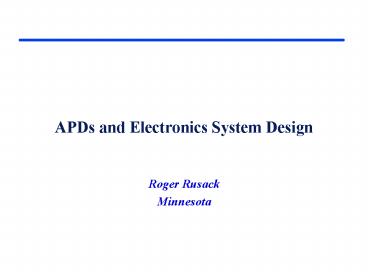APDs and Electronics System Design - PowerPoint PPT Presentation
1 / 20
Title:
APDs and Electronics System Design
Description:
Review of what we said in the proposal. Proposal from Hamamatsu ... Thermally Conductive Mousse. Other options are being considered see talk by Stuart Mufson ... – PowerPoint PPT presentation
Number of Views:39
Avg rating:3.0/5.0
Title: APDs and Electronics System Design
1
APDs and Electronics System Design
- Roger Rusack
- Minnesota
2
Outline
- Review of what we said in the proposal.
- Proposal from Hamamatsu
- What is between us and construction.
3
APD Housing Concepts
- We are making 30,000 modules so the design has
to begin with manufacturability. - We need to align the APDs with the fibers - the
better we do this the larger the fiber or the
smaller the APD. - The square pixel structure is not optimized for
the two-fiber readout. - We should stay within the same surface area of
silicon to keep close to the same price.
4
Current thinking
- We will use an APD array mounted on a PCB using
flip-chip technology. This provides an
alignment of 10??m to the PCB. Alignment is
reduced to aligning the fibers to the PCB. - Cooling by thermo-electric coolers to -15oC.
- Readout through very front-end designed by Tom
Zimmerman. - Front-end readout architecture still under
discussion.
5
Proposed APD Layout
Solder Bumps
Apperture in PCB for fibers.
6
APD pixels
Hole for Fiber connector
PCB substrate
2.3 mm gap
7
Basic Module concept.
Thermally Conductive Mousse
Present in one option
Support Ring
APD
ASIC
ADC
FPGA
TE Cooler
PCB
FiberConnector
FPGA for signal processing, IO and slow control.
Thermally isolated volume.
Air Gap
APD, ASICs and FPGA mounted onto PCB. Casing made
of injection molded components used to align
fiber connector and insulate/isolate APD.
Other options are being considered see talk by
Stuart Mufson
8
Status.
- Tests at Hamamatsu
- Flip chip method tested and Hamamatsu is happy
with the result - We have not seen the detailed
results. - Minimum distance to border is understood.
- APD layout with 10 pF matched to fibers defined.
- Quote from Hamamatsu
- NRE for wafer design and TE cooler attachment and
- 20 prototypes in aro. 6 months 10,000 ea.
- 40 prototypes in same time scale 6,250 ea.
Important point is that schedule is only 6 months.
9
Front-End Readout options.
- Two options have been considered for the design
of the front-end readout the APD. - Harvard design see talk by John Oliver later.
- Tom Zimmerman has designed a version of the
front-end ASIC.
10
Basic Concept
- Optimize design for low-noise readout during the
spill. - 32-channels to match the number of channels in a
module. - Track and hold amplifier which is sampled every
500 nsec for 30 microseconds to cover spill.
Samples are stored in a 64 deep switched
capacitor array (64 32). - After spill begin conversion process.
- 32 channels compared with linear ramp. 10-bit
resolution. - Covert next ramp and send out data.
- Repeat until all channels digitized.
- Digitize difference between odd neighbor cells OR
digitize each cell and subtract digitally.
11
Main Operation Spill Mode
Read Amplifier
Charge sensitive pre-amp
Shift Register
64 deep capacitor array
Latch
Comparitor
10
32 input channels
10
Linear Ramp Generator
Readout strobe
Collect signal in SCA
Digitize Later
12
Alternative Operation Fast Digitization Mode.
- Variants on the standard operation are included
in the design. - Direct in to latch.
- Non-linear ramp.
- Complete digitization in 400 nsec.
Read Amplifier
Latch
Comparitor
Non-linear ramp
13
Status
- Design complete.
- Full simulations complete. Calculated noise level
with 10 pf and 250 nsec shaping is 150 electrons.
Reality hope for expect 200. - Next step layout and produce short run in 0.25 m
process. - Plan is to submit this with other readout options.
14
Alternative Readout
- Alternative readout architecture which has same
operation in both spill and supernova detection
modes.
See talk by John Oliver later.
15
Development Schedule
- To go from initial design concepts to launch
production of 30,000 APD modules we need to - Design front-end readout ASIC.
- Design front-end board with all ancillary
circuits. - Prototype and test APD modules.
- Design, make and qualify cooling system.
- Build automated module testers for production.
- We need final versions of the prototype in
quantities of 10,000 channels by Feb 2007. - We need to start production of modules by Oct
2008. - Installation May 2009.
16
Immediate Tasks
- APD TE cooler design - Hamamatsu 6 Months
- Front-end electronics
- ASIC design, layout and fabrication - FNAL
Harvard. - PCB design layout and fabrication - FNAL.
- 400 V bias supply - Cockroft Walton or
distributed line? - TE cooler and controller.
- Test modules.
- Revisions.
- Module tester.
17
Short Term Schedule
ASIC development
DesignRevision
Test with prototype
18
Long Term Schedule
Test with prototype
Start mass productionJan/09
19
Other Major Issues
- Cooling TE cooler with water or air?
- Beam signal and clock distribution.
- Low Voltage network - Could be extensive.
- Trigger and DAQ
- Need to have an agreed set of specifications.
To be addressed in the coming months.
20
Summary
- APD structure
- Some progress with APD design. Optimized for 32
channel modularity. - ASIC design of one version complete. Designed to
meet beam and SN detector requirements. - Schedule
- There is much to be done on a short timescale.































